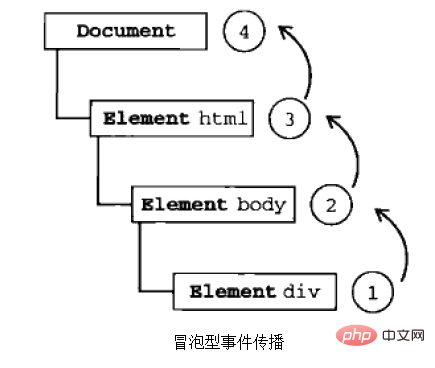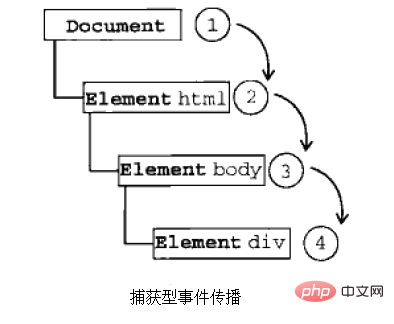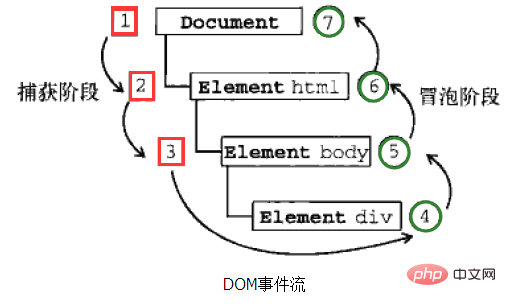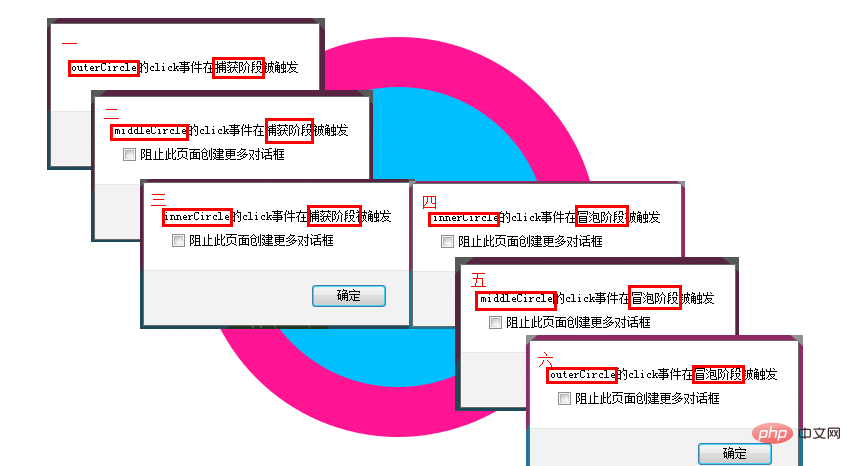What is event stream in JavaScript
In js, event flow is the order in which events are triggered between the target element and ancestor elements. According to the order of event propagation, event streams can be divided into two types: 1. Bubble-type event stream, in which events are propagated from the most specific event target to the least specific event target; 2. Capture-type event stream, in which events are propagated from From the least specific event target to the most specific event target.

The operating environment of this tutorial: windows7 system, javascript version 1.8.5, Dell G3 computer.
What is an event
An event is a specific moment of interaction that occurs in a document or browser window.
An event is a certain action performed by the user or the browser itself, such as click, load and mouseover are the names of the events.
Events are the bridge between javaScript and DOM.
If you trigger it, I will execute it - when the event occurs, its handler function is called to execute the corresponding JavaScript code to give a response.
Typical examples include: the load event is triggered when the page is loaded; the click event is triggered when the user clicks on an element.
What is event flow
When a specific event is triggered on an element on the page, such as a click, except For the clicked target element, all ancestor elements will trigger this event, all the way up to the window.
Then a question arises, should the event be triggered on the target element first, or on the ancestor element first? This is the concept of event flow.
Event flow is the sequence in which events are triggered between the target element and ancestor elements.
The early IE and Netscape proposed completely opposite event flow concepts. IE event flow is event bubbling, while Netscape's event flow is event capture.
Two event flow models
The order of event propagation corresponds to the two event flow models of the browser: capture event flow and bubbling type event stream.
Bubble event flow: The propagation of events is from to the most specific Event target to the least specific event target . That is, from the leaves of the DOM tree to the root. [Recommendation]
Capture-type event stream: The propagation of events is from The least specific of the event target to the most specific event target . That is, from the root of the DOM tree to the leaves.
The idea of event capture is that less specific nodes should receive events earlier, and the most specific nodes should receive events last.
<!DOCTYPE html>
<html>
<head>
<meta charset="UTF-8">
<title></title>
</head>
<body>
<div id="myDiv">Click me!</div>
</body>
</html>In the above html code, the
element in the page is clicked.
The order of click event propagation in the bubbling event stream is
click in the capture event stream The order of event propagation is document—》—》—》


note:
1), all modern browsers support event bubbling, but in There are slight differences in the specific implementation:
In IE5.5 and earlier versions, event bubbling will skip the element (jump directly from body to document).
IE9, Firefox, Chrome, and Safari bubble the event all the way to the window object.
2), IE9, Firefox, Chrome, Opera, and Safari all support event capture. Although the DOM standard requires that events should be propagated from the document object, these browsers capture events from the window object.
3). Since old versions of browsers do not support it, few people use event capture. It is recommended to use event bubbling.
2), DOM event flow
DOM标准采用捕获+冒泡。两种事件流都会触发DOM的所有对象,从document对象开始,也在document对象结束。

DOM标准规定事件流包括三个阶段:事件捕获阶段、处于目标阶段和事件冒泡阶段。
- 事件捕获阶段:实际目标(
)在捕获阶段不会接收事件。也就是在捕获阶段,事件从document到再到
就停止了。上图中为1~3. - 处于目标阶段:事件在
上发生并处理。但是事件处理会被看成是冒泡阶段的一部分。
- 冒泡阶段:事件又传播回文档。
note:
1)、尽管“DOM2级事件”标准规范明确规定事件捕获阶段不会涉及事件目标,但是在IE9、Safari、Chrome、Firefox和Opera9.5及更高版本都会在捕获阶段触发事件对象上的事件。结果,就是有两次机会在目标对象上面操作事件。
2)、并非所有的事件都会经过冒泡阶段 。所有的事件都要经过捕获阶段和处于目标阶段,但是有些事件会跳过冒泡阶段:如,获得输入焦点的focus事件和失去输入焦点的blur事件。
两次机会在目标对象上面操作事件例子:
<!DOCTYPE html>
<html>
<head>
<meta charset="UTF-8">
<title></title>
</head>
<style>
#outer{
position: absolute;
width: 400px;
height: 400px;
top:0;
left: 0;
bottom:0;
right: 0;
margin: auto;
background-color: deeppink;
}
#middle{
position: absolute;
width: 300px;
height:300px;
top:50%;
left: 50%;
margin-left: -150px;
margin-top: -150px;
background-color: deepskyblue;
}
#inner{
position: absolute;
width: 100px;
height:100px;
top:50%;
left:50%;
margin-left: -50px;
margin-top: -50px;;
background-color: darkgreen;
text-align: center;
line-height: 100px;
color:white;
}
#outer,#middle,#inner{
border-radius:100%;
}
</style>
<body>
<div id="outer">
<div id="middle">
<div id="inner">
click me!
</div>
</div>
</div>
<script>
var innerCircle= document.getElementById("inner");
innerCircle.addEventListener("click", function () {
alert("innerCircle的click事件在捕获阶段被触发");
},true);
innerCircle.addEventListener("click", function () {
alert("innerCircle的click事件在冒泡阶段被触发");
},false);
var middleCircle= document.getElementById("middle");
middleCircle.addEventListener("click", function () {
alert("middleCircle的click事件在捕获阶段被触发");
},true);
middleCircle.addEventListener("click", function () {
alert("middleCircle的click事件在冒泡阶段被触发");
},false);
var outerCircle= document.getElementById("outer");
outerCircle.addEventListener("click", function () {
alert("outerCircle的click事件在捕获阶段被触发");
},true);
outerCircle.addEventListener("click", function () {
alert("outerCircle的click事件在冒泡阶段被触发");
},false);
</script>
</body>
</html>运行效果就是会陆续弹出6个框,为说明原理我整合成了一个图:

【相关推荐:javascript视频教程、web前端】
The above is the detailed content of What is event stream in JavaScript. For more information, please follow other related articles on the PHP Chinese website!

Hot AI Tools

Undresser.AI Undress
AI-powered app for creating realistic nude photos

AI Clothes Remover
Online AI tool for removing clothes from photos.

Undress AI Tool
Undress images for free

Clothoff.io
AI clothes remover

AI Hentai Generator
Generate AI Hentai for free.

Hot Article

Hot Tools

Notepad++7.3.1
Easy-to-use and free code editor

SublimeText3 Chinese version
Chinese version, very easy to use

Zend Studio 13.0.1
Powerful PHP integrated development environment

Dreamweaver CS6
Visual web development tools

SublimeText3 Mac version
God-level code editing software (SublimeText3)

Hot Topics
 1382
1382
 52
52
 How to implement an online speech recognition system using WebSocket and JavaScript
Dec 17, 2023 pm 02:54 PM
How to implement an online speech recognition system using WebSocket and JavaScript
Dec 17, 2023 pm 02:54 PM
How to use WebSocket and JavaScript to implement an online speech recognition system Introduction: With the continuous development of technology, speech recognition technology has become an important part of the field of artificial intelligence. The online speech recognition system based on WebSocket and JavaScript has the characteristics of low latency, real-time and cross-platform, and has become a widely used solution. This article will introduce how to use WebSocket and JavaScript to implement an online speech recognition system.
 WebSocket and JavaScript: key technologies for implementing real-time monitoring systems
Dec 17, 2023 pm 05:30 PM
WebSocket and JavaScript: key technologies for implementing real-time monitoring systems
Dec 17, 2023 pm 05:30 PM
WebSocket and JavaScript: Key technologies for realizing real-time monitoring systems Introduction: With the rapid development of Internet technology, real-time monitoring systems have been widely used in various fields. One of the key technologies to achieve real-time monitoring is the combination of WebSocket and JavaScript. This article will introduce the application of WebSocket and JavaScript in real-time monitoring systems, give code examples, and explain their implementation principles in detail. 1. WebSocket technology
 How to use JavaScript and WebSocket to implement a real-time online ordering system
Dec 17, 2023 pm 12:09 PM
How to use JavaScript and WebSocket to implement a real-time online ordering system
Dec 17, 2023 pm 12:09 PM
Introduction to how to use JavaScript and WebSocket to implement a real-time online ordering system: With the popularity of the Internet and the advancement of technology, more and more restaurants have begun to provide online ordering services. In order to implement a real-time online ordering system, we can use JavaScript and WebSocket technology. WebSocket is a full-duplex communication protocol based on the TCP protocol, which can realize real-time two-way communication between the client and the server. In the real-time online ordering system, when the user selects dishes and places an order
 How to implement an online reservation system using WebSocket and JavaScript
Dec 17, 2023 am 09:39 AM
How to implement an online reservation system using WebSocket and JavaScript
Dec 17, 2023 am 09:39 AM
How to use WebSocket and JavaScript to implement an online reservation system. In today's digital era, more and more businesses and services need to provide online reservation functions. It is crucial to implement an efficient and real-time online reservation system. This article will introduce how to use WebSocket and JavaScript to implement an online reservation system, and provide specific code examples. 1. What is WebSocket? WebSocket is a full-duplex method on a single TCP connection.
 JavaScript and WebSocket: Building an efficient real-time weather forecasting system
Dec 17, 2023 pm 05:13 PM
JavaScript and WebSocket: Building an efficient real-time weather forecasting system
Dec 17, 2023 pm 05:13 PM
JavaScript and WebSocket: Building an efficient real-time weather forecast system Introduction: Today, the accuracy of weather forecasts is of great significance to daily life and decision-making. As technology develops, we can provide more accurate and reliable weather forecasts by obtaining weather data in real time. In this article, we will learn how to use JavaScript and WebSocket technology to build an efficient real-time weather forecast system. This article will demonstrate the implementation process through specific code examples. We
 How to use insertBefore in javascript
Nov 24, 2023 am 11:56 AM
How to use insertBefore in javascript
Nov 24, 2023 am 11:56 AM
Usage: In JavaScript, the insertBefore() method is used to insert a new node in the DOM tree. This method requires two parameters: the new node to be inserted and the reference node (that is, the node where the new node will be inserted).
 Simple JavaScript Tutorial: How to Get HTTP Status Code
Jan 05, 2024 pm 06:08 PM
Simple JavaScript Tutorial: How to Get HTTP Status Code
Jan 05, 2024 pm 06:08 PM
JavaScript tutorial: How to get HTTP status code, specific code examples are required. Preface: In web development, data interaction with the server is often involved. When communicating with the server, we often need to obtain the returned HTTP status code to determine whether the operation is successful, and perform corresponding processing based on different status codes. This article will teach you how to use JavaScript to obtain HTTP status codes and provide some practical code examples. Using XMLHttpRequest
 JavaScript and WebSocket: Building an efficient real-time image processing system
Dec 17, 2023 am 08:41 AM
JavaScript and WebSocket: Building an efficient real-time image processing system
Dec 17, 2023 am 08:41 AM
JavaScript is a programming language widely used in web development, while WebSocket is a network protocol used for real-time communication. Combining the powerful functions of the two, we can create an efficient real-time image processing system. This article will introduce how to implement this system using JavaScript and WebSocket, and provide specific code examples. First, we need to clarify the requirements and goals of the real-time image processing system. Suppose we have a camera device that can collect real-time image data




